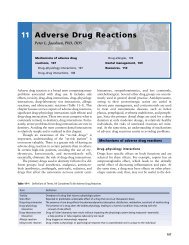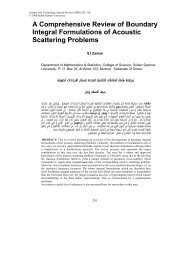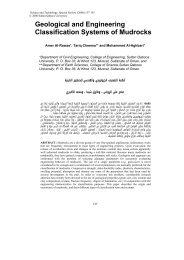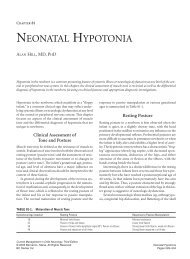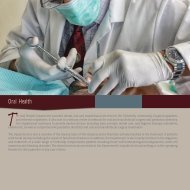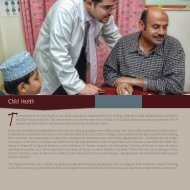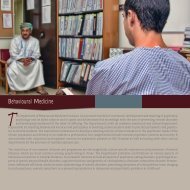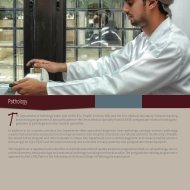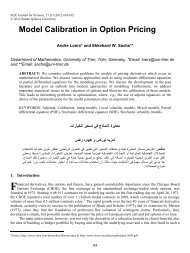Male Reproductive Toxicity - SQU Home
Male Reproductive Toxicity - SQU Home
Male Reproductive Toxicity - SQU Home
You also want an ePaper? Increase the reach of your titles
YUMPU automatically turns print PDFs into web optimized ePapers that Google loves.
TABLE 8Case-Control Studies of Paternal EffectsType of Exposure/OccupationAssociation withExposure a Effect Ref.Printing industry (+) Cleft lip 144Paint (+) Cleft palate 144Paint + Damage to CNS b 145Solvents (+) Damage to CNS b 145Low-level radiation + Neural tube defects 146Organic solvents + Spontaneous abortion 147Aromatic hydrocarbons + Spontaneous abortion 147Dusts + Spontaneous abortion 147Radiation + Childhood leukemia 148Welding + Time to conception 149Agriculture (+) Child brain tumor 150Construction (+) Child brain tumor 150Food/tobacco processing (+) Child brain tumor 150Metal + Child brain tumor 150Lead (+) Spontaneous abortion 151Lead (+) Congenital defects 152Ethylene glycol ether + Abnormal spermiogram 153Metals + Cadmium in semen 154a(+): marginally significant association; +: significant association.bCNS = central nervous system.Source: Modified from Taskinen, H., Scand. J. Work Environ. Health, 16, 297, 1990.and other data sources. Like population-based studies, case-control studies provide thestatistics needed to detect a rare event; however, in this type of study individual bias mayyield misleading results. A person who has experienced an adverse outcome may report anexposure more readily than one with no history of reproductive dysfunction. As Levindescribes, 81 a couple that has recently experienced a stillbirth or congenitally malformed childwill be more inclined to search for a previous toxic exposure as the source. Another potentialsource of bias in these studies exists with the interviewer, who should be “blind” to thereproductive status and the exposure classification of the respondent.2.3.4 Standardized Fertility RatioThe standardized fertility or birth ratio (SFR) (Table 9) provides a comparison of thenumber of observed births within a population to the number of expected births. The lattervalue is obtained using the birth rate of an external population. To monitor a specific workforcegroup, Wong 82 uses a simple standardization method that provides noninvasive, readilyavailable data. His method uses a couple’s reproductive history to measure male fecundity.The number of expected births is obtained from the birth rate for U.S. women of the sameage group. There are some problems with this simplified approach. Because the U.S. birthrate as collected by the National Center for Health Statistics does not take into accountmarital status, birth control, or frequency of intercourse, 83 the potential exists for a positiveor negative bias in making such comparisons. Wong’s method erroneously assumes all womento be equally libidinous and fecund. Additionally, because only married men are evaluated inSFR studies, there are age-related restrictions in the data as well as a likely underestimate ofthe number of children born out of wedlock. Some researchers have tried to correct for thesevariations in the population using different models. 83,84 It appears that the SFR overestimatesbirth rate in both control and exposed populations, even when a reduction in semen quality© 1999 by CRC Press LLC
TABLE 9Standarized Birth Ratio Studies of <strong>Male</strong> Fertility EffectsType of Exposure/OccupationAssociation withExposure aRef.Ethylene dibromide (+) 82DBCP + 83TDA and DNT – 78Mercury – 155Manganese + 155Ethylene glycol ether – 85Chemical-contaminated sewage – 156a–: no significant association; (+): marginally significantassociation; +: significant association.Source: Modified from Taskinen, H., Scand. J. Work Environ.Health, 16, 297, 1990.exists. 85 Levine 84 suggests SFR would be a reliable indicator in a cohort study in which bothcontrol and comparison population are selected on the same basis.2.3.5 Cohort StudiesCohort studies (Table 10) evaluate the frequency of adverse reproductive outcomebetween exposed and unexposed groups. Cross-sectional cohort studies evaluate the groupsas they currently exist, whereas historical cohort studies are conducted on previously exposedand unexposed groups. An example of the latter is the 1989 Vietnam experience study inwhich military veterans were grouped according to whether or not they had served in Vietnamfrom 1967 to 1972. 86 This study was able to detect subsequent differences between thegroups in semen quality and time to pregnancy but revealed little about the reproductivehealth of the individuals at the time of exposure.A cohort study may be longitudinal (prospective). In such a study, baseline data arecollected, and individuals are studied over time for a specific reproductive outcome. Alongitudinal study is exemplified by the study of “summer hire” pesticide applicators. 41Individuals were evaluated at the beginning of the season before they started working withpesticides and at the conclusion of the spraying season 2 months later. This report illustratesthe importance of selecting appropriate variables for a study design. If semen analyses areconducted to predict reproductive outcome, the correct time frame is needed. Since the timefor spermatogenesis and delivery of mature sperm to the ejaculate is approximately 72 days,if primary spermatogonia were affected by exposure, this would not be observed in a timeframe covering less than 80 to 90 days. Thus, the study of “summer hire” workers could notmake valid conclusions regarding the effects of a 2-month exposure to pesticide applicationon spermatogenesis.Cohort studies may involve questionnaires, neuroendocrine measurements, and semenanalyses or a combination of these. Questionnaire studies are advantageous in that they arethe least expensive and least invasive. As with case control studies, however, inherent problemsexist, such as possible interviewer bias and the selective memory of respondents who haveexperienced an adverse outcome. Additionally, many cohort studies lack the number ofpregnancies needed to detect differences between groups. 87 Studies evaluating the neuroendocrinesystem measure male hormones in blood samples. Although blood sampling is awidely accepted medical practice, it is an invasive procedure, and the endocrine profile doesnot necessarily reflect the status of the male reproductive system. 88 Semen analysis provides© 1999 by CRC Press LLC
TABLE 11Clinical/Case Studies of <strong>Male</strong> <strong>Reproductive</strong> Effects withPositive Association with ExposureType of Study Type of Exposure Effect Ref.Cluster DBCP Semen, endocrine 181Case report Kepone Semen 93Medical monitor Lead Semen 182Case report Methylene chloride Semen 183Case report Lead Semen 92Accident Bromine vapor Semen 76Accident Radiation Semen, endocrine 77therapy. His sperm count increased as his blood levels decreased, and he subsequently fatheredanother child after the level of lead decreased below 30 mg/dl. Similarly, after men exposedto high levels of kepone in the work environment were treated with cholestyramine to offsetthe toxic action of kepone, their sperm count and sperm motility increased accordingly. 93Work-related accidents may provide case study data on high-level exposures. These inturn may indicate the parameters to be studied at lower exposures.3 SURVEILLANCE OF MALE REPRODUCTIONA surveillance strategy for evaluating men working with known male reproductive toxicantswas proposed and conducted by a team from the University of California; 94 however,this program had many problems and was eventually discontinued. 95 While this first attemptwas discouraging, chemicals such as lead and ethylene glycol ethers remain in the U.S.workplace, posing a hazard to the reproductive health of the male worker. A surveillanceprogram is required to monitor those working with these and other occupational toxicants.3.1 SUSCEPTIBILITY OF SUBGROUPSThere is a concern that there may be a subgroup of individuals that may be moresusceptible to a toxicant than others in the population. While for male reproductive toxicantsin humans this has not been tested, there are some indications that it may in fact happen insome cases. Chapin et al. 96 have shown that different strains of mice respond differently dothe same toxicant. Their data indicate that a strain of mice known to be “poor breeders”were more sensitive to the toxicant 2-methoxyethanol than strains of “good breeders”. Asimilar response was noted by Welch et al., 97 who reported on a study in which workers wereexposed to a related compound, 2-ethoxyethanol. In this human study, the exposed workershad a median sperm count similar to the unexposed comparison group; however, when thedistribution of sperm counts was evaluated, it appeared that the number of sperm of menwith low sperm counts was much lower. This suggested that a man with a lower sperm countsuffered a severe decrement compared to others in the population with exposure.3.2 DECLINING SPERM COUNTSMuch has been written about declining male fecundity in recent years. 68,98,99 The reporteddecline in sperm numbers has received the most attention. Such reports are not necessarilynew, as this controversy has been debated before. 63-67 What appears different is that the© 1999 by CRC Press LLC
popular press has sensationalized these reports. While there is evidence that sperm numbershave changed, one must be cautious, remembering that both andrology and laboratorymethodology have changed over the last half century. Are the observed changes a reflectionof study participants and/or methodology, and are they real? 100-102 Related to this currentcontroversy are reports that this decline is due to male offspring being exposed in utero toestrogenic compounds from our environment. While exposure to estrogenic (and otherhormonal) compounds in utero can have negative effects on sperm production, 103 a directcause and effect have not been shown between estrogenic compounds and a decline of spermnumbers in the human race. This is an interesting hypothesis that needs much more research.4 SUMMARYThe male reproductive system is susceptible to toxic insult that results in decreasedfecundity and/or an increase in adverse pregnancy. Each year, several hundred new compoundsare added to the 70 thousand compounds and 4 million mixtures already in commercialuse, 104 suggesting that there is a need to evaluate the effects that a man’s workplaceand environment has on his fecundity. There are several methods for evaluating male fecundity,often requiring a large research team and complex laboratory assessments. While the problemsin conducting such a study may seem unsurmountable, a team approach has allowed thisresearch to be successful. 91REFERENCES1. Sokol, R. Z., Endocrine evaluations in the assessment of male reproductive hazards, Reprod. Toxicol., 2,217–222, 1988.2. Schrader, S. M., Turner, T. W., Breitenstein, M. J., and Simon, S. D., Measurement of male reproductivehormones for field studies, J. Occup. Med., 35, 574–576, 1993.3. Bardin, C. W., Pituitary-testicular axis, in <strong>Reproductive</strong> Endocrinology, Yen, S. S. C. and Jaffe, R. B., Eds.,W.B. Saunders, Philadelphia, 1986, pp. 177–199.4. Raid-Fahmy, D., Read, G. F., Walker, R. F., and Griffiths, K., Steroids in saliva for assessing endocrinefunction, Endocrinol. Rev., 3, 367–395, 1982.5. Apostoli, P., Romeo, L., Peroni, E., Ferioli, A., Ferrari, S., Pasini, F., and Aprili, F., Steroid hormone sulphationin lead workers, Br. J. Ind. Med., 46, 204–208, 1989.6. Plant, T. M., Puberty in primates, in The Physiology of Reproduction, Knobil, E. and Neill, J. D., Eds., RavenPress, New York, 1988, pp. 1763–1788.7. NIOSH, Collecting a Semen Sample, National Institute for Occupational Safety and Health, Cincinnati, OH,1986.8. Eliasson, R. and Treichl, L., Supravital staining of human spermatozoa, Fertil. Steril., 22, 134–137, 1971.9. Jeyendran, R. S., Van den Ven, H. H., Perez-Palaez, M., Crabo, B. G., and Zaneveld, L. J. D., Developmentof an assay to assess the functional integrity of the human sperm membrane and its relationship to othersemen characteristics, J. Reprod. Fertil., 70, 219–228, 1984.10. Schrader, S. M., Platek, S. F., Zaneveld, L. J. D., Perez-Palaez, M., and Jeyendran, R. S., Sperm viability: acomparison of analytical methods, Andrologia, 18, 530–538, 1986.11. MacLeod, J., Semen quality in 1000 men of known fertility and in 800 cases of infertile marriage, Fertil.Steril., 2, 115–139, 1951.12. Freund, M., Standards for the rating of human sperm morphology, Int. J. Fertil., 11, 97–180, 1966.13. Fredricson, B., Morphologic evaluation of spermatozoa in different laboratories, Andrologia, 11, 57–61, 1979.14. Hanke, L. J., Comparison of Laboratories Conducting Sperm Morphology, Report TA78-28, National Institutefor Occupational Safety and Health, Cincinnati, OH, 1981.15. Schmassmann, A., Mikuz, G., Bartsch, G., and Rohr, H., Quantification of human sperm morphology andmotility by means of semi-automatic image analysis systems, Microscopica Acta, 82, 163–178, 1979.16. Katz, D. F., Overstreet, J. W., and Pelprey, R. J., Integrated assessment of the motility, morphology andmorphometry of human spermatozoa, INSERM, 103, 97–100, 1981.© 1999 by CRC Press LLC
17. Schrader, S. M., Turner, T. W., Hardin, B. D., Niemeier, R. W., and Burg, J. R., Morphometric analysis ofhuman spermatozoa, J. Androl., 5, 22, 1984.18. Jagoe, J. R., Washbrook, N. P., and Hudson, E. A., Morphometry of spermatozoa using semiautomatic imageanalysis, J. Clin. Pathol., l39, 1347–1352, 1986.19. DeStefano, F., Annest, J. L., Kresnow, M. J., Flock, M. L., and Schrader, S. M., Automated semen analysisin large epidemiologic studies, J. Androl., 8, 24, 1987.20. Turner, T. W., Schrader, S. M., and Simon, S. D., Sperm head morphometry as measured by three differentcomputer systems, J. Androl., 9, 45, 1988.21. Moruzzim J. F., Wyrobek, A. J., Mayall, B. H., and Gledhill, B. L., Quantification classification of humansperm morphology by CASA, Fertil. Steril., 50, 142–152, 1988.22. Schrader, S. M., Ratcliffe, J. M., Turner, T. W., and Hornung, R. W., The use of new field methods of semenanalysis in the study of occupational hazards to reproduction: the example of ethylene dibromide, J. Occup.Med., 29, 963–966, 1987.23. Zukerman, Z., Rodriguez-Rigau, L. J., Weiss, D. B., Chowdhury, A. K., Smith, K. D., and Steinberger, E.,Quantitative analysis of the seminiferous epithelium in human testicular biopsies, and the relation of spermatogenesisto sperm density, Fertil. Steril., 30, 448–455, 1978.24. Whorton, D., Milby, T. H., Krauss, R. M., and Stubbs, H. A., Testicular function in DBCP-exposed pesticideworkers, J. Occup. Med., 21, 161–166, 1979.25. Potashnik, G. and Abeliovich, D., Chromosomal analysis and health status of children conceived to menduring or following dibromochloropropane-induced spermatogenic suppression, Andrologia, 17, 291–296,1985.26. Ratcliffe, J. M., Schrader, S. M., Steenland, K., Clapp, D. E., Turner, T., and Hornung, R. W., Semen qualityin papaya workers with long term exposure to ethylene dibromide, Br. J. Ind. Med., 44, 317–326, 1987.27. Schrader, S. M. and Kanitiz, M. H., Occupational hazards to male reproduction, in State of the Art Reviewsin Occupational Medicine: <strong>Reproductive</strong> Hazards, Gold, E., Schenker, M., and Lasley, B., Eds., Hanley &Belfus, Philadelphia, 1994, pp. 405–414.28. Olshan, A. F. and Mattison, D. R., <strong>Male</strong> Mediated Development <strong>Toxicity</strong>, Plenum Press, New York, 1994.29. Martin, R. H., A detailed method for obtaining preparations of human sperm chromosomes, Cytogenet. CellGenet., 35, 252–256, 1983.30. Martin, R. H., Detection of genetic damage in human sperm, Reprod. Toxicol., 7(Suppl. 1), 47–52, 1993.31. Estop, A. M., Marquez, C., Munne, S., Navarro, J., Cieply, K., Vankirk, V., Martorell, M. R., Benet, J., andTemplado, C., An analysis of human sperm chromosome breakpoints, Am. J. Human Genet., 56, 452–460,1995.32. Evenson, D. P., Flow cytometry of acridine orange-stained sperm is a rapid and practical method formonitoring occupational exposure to genotoxicants, in Monitoring Occupational Genotoxicity, Sorsa, M. andNorppa, H., Eds., Alan R. Liss, New York, 1986, pp. 121–132.33. Evenson, D. P., Jost. L. K., Baer, R. K., Turner, T. W., and Schrader, S. M., Individuality of DNA denaturationpatterns in human sperm as measured by the sperm chromatin structure assay, Reprod. Toxicol., 5(2), 115–125,1991.34. Spano, M. and Evenson, D. P., Flow cytometric studies in reproductive toxicology, in New Horizons inBiological Dosimetry, Gledhill, B. L. and Mauro, F., Eds., Wiley-Liss, New York, 1991, pp. 497–511.35. Holmes, J. M. and Martin, R. H., Aneuploidy detection in human sperm nuclei usisng fluorescence in situhybridization, Human Genet., 91, 20–24, 1993.36. Wyrobek, A. J., Robbins, W. A., Mehraein, Y., Pinkel, D., and Weier, H. U., Detection of sex chromosomalaneuploidies X-X, Y-Y, and X-Y in human sperm using two-chromosome fluorescence in situ hybridization,Am. J. Med. Genet., 53, 1–7, 1994.37. Bischoff, F. Z., Nguyen, D. D., Burt, K. J., and Shaffer, L. G., Estimates of aneuploidy using multicolorfluorescence in situ hybridization on human sperm, Cytogenet. Cell Genet., 66, 237–243, 1994.38. Stachel, B., Dougherty, R. C., Lahl, U., Schlosser, M., and Zeschmar, B., Toxic environmental chemicals inhuman semen: analytical method and case studies, Andrologia, 21, 282–291, 1989.39. Zikarge, A., Cross-Sectional Study of Ethylene Dibromide-Induced Alterations of Seminal Plasma Biochemistryas a Function of Post-Testicular <strong>Toxicity</strong> with Relationships to Some Indices of Semen Analysis andEndocrine Profile, Dissertation to the University of Texas Health Science Center, Houston, TX, 1986.40. Mann, T. and Lutwak-Mann, C., Passage of chemicals into human and animal semen: mechanisms andsignificance, CRC Crit. Rev. Toxicol., 11, 1–14, 1982.41. Schrader, S. M., Turner, T. W., and Ratcliffe, J. M., The effects of ethylene dibromide on semen quality: acomparison of short term and chronic exposure, Reprod. Toxicol., 2, 191–198, 1988.42. Yazigi, R. A., Odem, R. R., and Polakoski, K. L., Demonstration of specific binding of cocaine to humanspermatozoa, J. Am. Med. Assoc., 266, 1956–1959, 1991.43. Aitkin, R. J., Development of in vitro tests of human sperm function: a diagnostic toll and model system fortoxicological analyses, Toxic. In Vitro, 4, 560–569, 1990.44. Katz, D. F., Overstreet, J. W., and Hanson, F. W., A new quantitative test for sperm penetration into cervicalmucus, Fertil. Steril., 33, 179–186, 1980.© 1999 by CRC Press LLC
45. Niederberger, C. S., Lamb, D. J., Glinz, M., Lipshultz, L. I., and Scully, N. F., Tests of sperm function forevaluation of the male — Penetrak-Asterisk and Tru-Trax, Fertil. Steril., 60, 319–323, 1993.46. Biljan, M. M., Taylor, C. T., Manasse, P. R., Joughin, E. C., Kingsland, C. R., and Lewisjones, D. I.,Evaluation of different sperm function tests as screening methods for male fertilization potential — the valueof the sperm migration test, Fertil. Steril., 62, 591–598, 1994.47. Rogers, B. J., Use of SPA in assessing toxic effects on male fertilizing potential, Reprod. Toxicol., 2, 233–240,1988.48. Coddington, C. C., Franken, D. R., Burkman, L. J., Oosthuizen, W. T., Kruger, T., and Hodgen, G. D.,Functional aspects of human sperm binding to the zona-pellucida using the hemizona assay, J. Andrology,12, 1–8, 1991.49. Franken, D. R., Acosta, A. A., Kruger, T. F., Lombard, C. J., Ochninger, S., and Hodgen, G. D., Thehemizona assay — its role in identifying male factor infertility in assisted reproduction, Fertil. Steril., 59,1075–1080, 1993.50. Schrader, S. M., Turner, T. W., and Simon, S. D., Sources of variation of the sperm penetration assay underfield study conditions, Assist. Reprod. Technol. Androl., 2(Suppl. 4), 63–74, 1991.51. deGroat, W. C. and Booth, A. M., Physiology of male sexual function, Am. Intern. Med., 92, 329–331, 1980.52. Thomas, Jr., A. J., Ejaculatory dysfunction, Fertil. Steril., 39, 445–454, 1983.53. Krane, R. J., Goldstein, I., and de Tejada, I. S., Impotence, N. Engl. J. Med., 321, 1648–1659, 1989.54. Burris, A. S., Banks, S. M., and Sherins, R. J., Quantitative assessment of nocturnal penile tumescence andrigidity in normal men using a home monitor, J. Androl., 10, 492–497, 1989.55. Dixon, R. L., Sherins, R. J., and Lee, I. P., Assessment of environmental factors affecting male fertility,Environ. Health Perspec., 30, 53–68, 1979.56. Fabro, S., Ed., <strong>Reproductive</strong> Toxicology: A Medical Letter on Environmental Hazards to Reproduction, <strong>Reproductive</strong>Toxicology Center, Washington, D.C., 1985.57. Manson, J. and Simons, R., Influence of environmental agents on male reproductive failure, in Work and theHealth of Women, Hunt, V. R., Ed., CRC Press, Boca Raton, FL, 1979.58. Sever, L. E. and Hessol, N. A., Toxic effects of occupational and environmental chemicals on the testes, inEndocrine Toxicology, Thomas, J. A., Ed., Raven Press, New York, 1985.59. Thomas, J. A., <strong>Reproductive</strong> hazards and environmental chemicals: a review, Toxic Substances J., 2, 318–348,1981.60. American Fertility Society, What you should know about infertility, Contemp. Ob.-Gyn., 15, 101–105, 1980.61. Rantala, M. L., Epidemiological and Clinical Studies on the Etiology of Infertility, Dissertation, Universityof Helsinki, Finland, 1988.62. Purvis, K and Christiansen, E., <strong>Male</strong> infertility — current concepts, Ann. Med., 24, 259–272, 1992.63. Nelson, C. K. M. and Bunge, R. G., Semen analysis: evidence for changing parameters of male fertilitypotential, Fertil. Steril., 26, 503–507, 1974.64. Bostofte, E., Serup, J., and Rebbe, H., Has the fertility of Danish men declined through the years in termsof semen quality? A comparison of semen qualities between 1952 and 1972, Int. J. Fertil., l28, 91–95, 1983.65. Osser, O. Liedholm, P., and Ranstam, J., Depressed semen quality: a study over two decades, Arch. Androl.,12, 113–116, 1984.66. Menkveld, R., Van Zyl, J. A., Kotze, T. J. W., and Joubert, G., Possible changes in male fertility over 15-year period, Arch. Androl., 17, 143–144, 1986.67. James, W. H., Secular trends in reported sperm count, Andrologia, 12, 381–388, 1980.68. Carlsen, E., Giwercman, A., Keiding, N., and Skakkebaek, N. E., Evidence for decreasing quality of semenduring past 50 years, Br. Med. J., 305, 609–613, 1992.69. Kaur, S., Effect of environmental pollutants on human semen, Environ. Contam. Toxicol., 40, 102–104, 1988.70. Stachel, B., Daugherty, R. C., Lahl, U., Schlosser, M., and Zeschmer, B., Toxic environmental chemicals inhuman semen — analytical method and case studies, Andrologia, 21, 282–291, 1989.71. Gangi, G. R. and Nagler, H. M., Clinical evaluation of the subfertile man, Infertil. Reprod. Med. Clin. N.Am., 3, 299–318, 1992.72. Drife, J. O., The effects of drugs on sperm, Drugs, 33, 610–622, 1987.73. Whorton, D. and Foliart, D., DBCP: Eleven Years Later, NIOSH Symposium on the Assessment of <strong>Reproductive</strong>Hazards in the Workplace, Presentation June 16, Cincinnati, OH, 1988.74. Sas, M. and Szollosi, J., Impaired spermatogenesis as a common finding among professional drivers, Arch.Androl., 3, 57–60, 1979.75. Rosenberg, M. J., Wyrobek, A. J., Ratcliffe, J., Gordon, L. A., Watchmaker, G., Fox, S. H., Moore, II, D.H., and Hornung, R. W., Sperm as an indicator of reproductive risk among petroleum refinery workers, Br.J. Ind. Med., 42, 123–127, 1985.76. Potashnik, G., Carel, R., Belmaker, I., and Levine, M., Spermatogenesis and reproductive performancefollowing human accidental exposure to bromine vapor, Reprod. Toxicol., 6, 171–174, 1992.77. Birioukov, A., Meurer, M., Peter, R. U., Braun-Falco, O., and Plewig, G., <strong>Male</strong> reproductive system inpatients exposed to ionizing irradiation in the Chernobyl accident, Arch. Androl., 3, 99–104, 1993.© 1999 by CRC Press LLC
78. Hamill, P. V. V., Steinberger, E., Levine, R. J., Rodriguez-Rigau, L. J., Lemeshow, S., and Avrunin, J. S.,The epidemiologic assessment of male reproductive hazard from occupational exposure to TDA and DNT,J. Occup. Med., 24, 985–993, 1982.79. Colie, C. F., <strong>Male</strong>-mediated teratogenesis, Reprod. Toxicol., 7, 3–9, 1993.80. Davis, D. L., Friedler, G., Mattison, D., and Morris, R., <strong>Male</strong>-mediated teratogenesis and other reproductiveeffects — biologic and epidemiologic findings and a plea for clinical research, Reprod. Toxicol., 6, 289–292,1992.81. Levin, S. M., Problems and pitfalls in conducting epidemiological research in the area of reproductivetoxicology, Am. J. Ind. Med., 4, 349–364, 1983.82. Wong, O., Utidijian, H. M. D., and Karten, V. S., Retrospective evaluation of reproductive performance ofworkers exposed to ethylene dibromide (EDB), J. Occup. Med., 21, 98–102, 1979.83. Levine, R. J., Blunden, P. B., Dalcorso, D., Starr, L. B., and Ross, C. E., Superiority of reproductive historiesto sperm count in detecting infertility at dibromochloropropane manufacturing plant, J. Occup. Med., 25,591–597, 1983.84. Levine, R. J., Monitoring fertility to detect toxicity to the male reproductive system, Reprod. Toxicol., 2,223–227, 1988.85. Welch, L. S., Plotkin, E., and Schrader, S., Indirect fertility analysis in painters exposed to ethylene glycolethers: sensitivity and specificity, Am. J. Ind. Med., 20, 229–240, 1991.86. Destefano, F., Annest, J. L., Kresnow, M.-J., Schrader, S. M., and Katz, D. F., Semen characteristics ofVietnam veterans, Reprod. Toxicol., 3, 165–173, 1989.87. Schrader, S. M., Ratcliffe, J. M., Turner, T. W., and Hornung, R. W., The use of new field methods of semenanalysis in the study of occupational hazards to reproduction: the example of ethylene dibromide, J. Occup.Med., 29, 963–966, 1987.88. Assennato, G., Paci, C., Baser, M. E., Molinini, R., Candela, G., Altamura, B. M., and Giorgino, R., Spermcount suppression without endocrine dysfunction in lead-exposed men, Arch. Environ. Health, 41, 387–390,1986.89. Schrader, S. M. and Kesner, J. S., Mechanisms of male reproductive toxicology, in Occupational and Environmental<strong>Reproductive</strong> Hazards: A Guide for Clinicians, Paul, M., Ed., Williams & Wilkins, Baltimore, MD,1992, pp. 3–17.90. Schrader, S. M., Chapin, R. E., Clegg, E. D., Davis, R. O., Fourcroy, J. L., Katz, D. F., Rothmann, S. A.,Toth, G., Turner, T. W., and Zinaman, M., Laboratory methods for assessing human semen in epidemiologicstudies: a consensus report, Reprod. Toxicol., 6, 275–279, 1992.91. Schrader, S. M., General techniques for assessing male reproductive potential in human field studies, inMethods in <strong>Reproductive</strong> Toxicology, Vol. 3, Chapin, R. and Heindel, J., Eds., Academic Press, San Diego,1993, pp. 362–371.92. Fisher-Fischbein, J., Fischbein, A., Melnick, H. D., and Bardin, C. W., Correlation between biochemicalindicators of lead exposure and semen quality in a lead-poisoned firearms instructor, J. Am. Med. Assoc., 257,803–805, 1987.93. Cohn, W. J., Boylan, J. J., Blanke, R. V., Farris, M. W., Howell, J. R., and Guzelian, P. S., Treatment ofchlordecone (kepone) toxicity with cholestyramine; results of a controlled clinical trial, New Engl. J. Med.,298, 243–248, 1975.94. Schenker, M. B., Samules, S. J., Perkins, C., Lewis, E. L., Katz, D. F., and Overstreet, J. W., Prospectivesurveillance of semen quality in the workplace, J. Occup. Med., 30, 336–344, 1988.95. Samuels, S. J., Lessons from a surveillance program of semen quality, Reprod. Toxicol., 2, 229–231, 1988.96. Chapin, R. E., Morrissey, R. E., Gulati, D. K., Hope, E., Barnes, L. H., Russell, S. A., and Kennedy, S. R.,Are mouse strains differentially susceptible to the reproductive toxicity of ethylene glycol monomethyl ether?A study of 3 strains, Fundam. Appl. Toxicol., 21, 8–14, 1993.97. Welch, L. S., Schrader, S. M., Turner, T. W., and Cullin, M. R., Effects of exposure to ethylene glycol etherson shipyard painters. I. <strong>Male</strong> reproduction, Am. J. Ind. Med., 14, 509–526, 1988.98. van Waeleghem, K., DeClercq, N., Vermeulen, L., Schoonjans, F., and Comhaire, F., Deterioration of spermquality in young Belgium men during recent decades, Hum. Reprod., 9(Suppl. 4), 73, 1994.99. Auger, J., Kunstmann, J. M., Czyglik, F., and Jouannet, P., Decline in semen quality among fertile men inParis during the past 20 years, New Engl. J. Med., 332, 281–285, 1995.100. Bromwich, P., Cohen, J., Stewart, I., and Walker, A., Decline in sperm counts: an artefact of changed referencerange of “normal”?, Br. Med. J., 309, 19–22, 1994.101. Farrow, S., Falling sperm quality: fact or fiction?, Br. Med. J., 309, 1–2, 1994.102. Sherins, R. J., Are semen quality and male fertility changing?, New Engl. J. Med., 332, 327, 1995.103. Schardein, J. L., Hormones and hormonal antagonists, in Chemically Induced Birth Defects, Marcel Dekker,New York, 1993, pp. 271–340.104. USEPA, Chemical Substance Inventory, EPA 620-929/0027/1985, U.S. Environmental Protection AgencyOffice of Toxic Substances, U.S. Government Printing Office, Washington, D.C., 1990.105. Levine, R., Bordson, B. L., Mathew, R. M., Brown, M. H., Stanley, J. M., and Starr, T. B., Deterioration ofsemen quality during summer in New Orleans, Fertil. Steril., 49, 900–907, 1988.© 1999 by CRC Press LLC
106. Levine, R. J., Mathew, R. M., Chenault, C. B., Brown, M. H., Hurtt, M. E., Bentley, K. S., Mohr, K. L.,and Working, P. K., Differences in the quality of semen in outdoor workers during summer and winter, NewEngl. J. Med., 323, 12–16, 1990.107. Levine, R. J., Brown, M. H., Bell, M., Shue, F., Greenberg, G. N., and Bordson, B. L., Air-conditionedenvironments do not prevent deterioration of human seman quality during the summer, Fertil. Steril., 57,1075–1083, 1992.108. Ieffendy, W. K., Environmental risk factors in the history of male patients of an infertility clinic, Andrologia,19, 262–265, 1987.109. Mieusset, R., Association of scrotal hyperthermia with impaired spermatogenesis in infertile men, Fertil.Steril., 48, 1006–1011, 1988.110. McGrady, A. V., Effects of psychological stress on male reproduction: a review, Arch. Androl., 13, 1–7, 1984.111. Steeno, O. P. and Pangkahila, A., Occupational influences on male fertility and sexuality, Andrologia, 16,93–101, 1984.112. Giblin, M. P., Effects of stress and characteristic adaptability on semen quality in healthy men, Fertil. Steril.,49, 127–132, 1988.113. Harrison, K. L., Stress and semen quality in an in vitro fertilization program, Fertil. Steril., 48(4), 633–636,1987.114. Sanger, W. G. and Friman, P. C., Fit of underwear and male spermatogenesis — a pilot investigation, Reprod.Toxicol., 4(3), 229–232, 1990.115. Shafik, A., Ibrahim, I. H., and Elsayed, E. M., Effect of different types of textile fabric on spermatogenesis.I. Electrostatic potentials generated on surface of human scrotum by wearing different types of fabric,Andrologia, 24, 145–147, 1992.116. Mikamo, K., Kamiguchi, Y., and Tateno, H., Spontaneous and in vitro radiation-induced chromosomeaberrations in human spermatozoa — application of a new method, Mutat. Environ. B, 340, 447–456, 1990.117. Meistrich, M. L., Reduction in sperm levels after testicular irradiation of the mouse: a comparison with man,Radiat. Res., 102, 138–147, 1985.118. Martin, R. H., Hildebrand, K., Yamamoto, J., Rademaker, A., Barnes, M. et al., An increased frequency ofhuman sperm chromosomal abnormalities after radiotherapy, Mutat. Res., 174, 219–225, 1986.119. Mattison, D. R., Bogumil, J., Chapin, R., Hatch, M., Hendrix, A., Jarrell, J., Labarbera, A., Schrader, S.,and Selevan, S., <strong>Reproductive</strong> toxicology of pesticides, in Advances in Modern Environmental Toxicology,Baker, S. R. and Wilkinson, C. F., Eds., Scientific Press, Princeton, NJ, 1990, pp. 263–348.120. Beall, C. M., Worthman, C. M., Stallings, J., Strohl, K. P., Brittenham, G. M., and Barragan, M., Salivarytestosterone concentration of Aymara men native to 3600 m, Ann. Human Biol., 19(1), 67–78, 1992.121. Garciahjarles, M. A., Spermatogram and seminal biochemistry of high altitude natives and patients withchronic mountain sickness, Arch. Biol. Med. Exp., 1989.122. Ucheria, K., Semen analysis in alcohol dependence syndrome, Andrologia, 17, 558–563, 1985.123. Ida, Y., Tsujimaru, S., Nakamaura, K., Shirao, I., Mukasa, H., Egami, H. et al., Effects of acute and repeatedalcohol ingestion on hypothalamic-pituitary-gonadal and hypothalamic-pituitary-adrenal functioning in normalmales, Drug Alcohol Dependence, 31, 57–64, 1992.124. Savitz, D. A., Schwingl, P. J., and Keels, M. A., Influence of paternal age, smoking, and alcohol consumptionon congenital anomalies, Teratology, 44(4), 429–440, 1991.125. Nirenberg, T. D., Liepman, M. R., Begin, A. M., Doolittle, R. H., and Broffman, T. E., The sexual relationshipof male alcoholics and their female partners during periods of drinking and abstinence, J. Stud. Alcohol, 51(6),565–568, 1990.126. Bain, C. L. and Guay, A. T., Reproducibility in monitoring nocturnal penile tumescence and rigidity, J. Urol.,148, 811–814, 1992.127. Attia, A. M., Cigarette smoking and male reproduction, Arch. Androl., 23, 45–49, 1989.128. Stillman, R. J., Rosenberg, M. J., and Sachs, B. P., Smoking and reproduction, Fertil. Steril., 46, 545–566,1986.129. Holzki, G., Gall, H., and Hermann, J., Cigarette smoking and sperm quality, Andrologia, 23, 141–144, 1991.130. Smith, R. C., Drug abuse and reproduction, Fertil. Steril., 48, 355–373, 1987.131. Fabro, S., Drugs and <strong>Male</strong> Sexual Function. <strong>Reproductive</strong> Toxicology: A Medical Letter, Vol. 4, <strong>Reproductive</strong>Toxicology Center, Washington, D.C., 1985.132. Ayers, J. W. T., Komesu, Y., Romani, T., and Ansbacher, R., Anthropomorphic, hormonal and psychologiccorrelates of semen quality in endurance-trained male athletes, Fertil. Steril., 43, 917–921, 1985.133. Grandi, M. and Celani, M. F., Effects of football on the pituitary-testicular axis (PTA) — differences betweenprofessional and non-professional soccer players, Exp. Clin. Endocrinol., 96, 253–259, 1990.134. Marshburn, P. B. et al., Semen quality and association with coffee drinking, cigarette smoking, and ethanolconsumption, Fertil. Steril., 52, 162–165, 1989.135. Beach, C. A., Bianchine, J. R., and Gerber, N., The excretion of caffeine in the semen of men: pharmacokineticsand comparison in the concentrations in blood and semen, J. Clin. Pharmacol., 24, 120–126, 1984.136. Brown-Woodman, P. D. C., Post, E. J., Gass, G. C., and White, I. G., The effect of a single sauna exposureon spermatozoa, Arch. Endrol., 12, 9–15, 1984.© 1999 by CRC Press LLC
137. Lindbohm, M.-L., Hemminki, K., and Kyyronen, P., Parental occupational exposure and spontaneous abortionsin Finland, Am. J. Epidemiol., 120, 370–378, 1984.138. Daniell, W. E. and Vaughan, T. L., Paternal employment in solvent related occupations and adverse pregnancyoutcomes, Br. J. Ind. Med., 45, 193–197, 1988.139. McDonald. A. D., McDonald, J. C., Armstrong, B., Cherry, N. M., Nolin, A. D., and Robert, D., Fathers’occupation and pregnancy outcome, Br. J. Ind. Med., 46, 329–333, 1989.140. Lindbohm, M. L., Hemminki, K., Bonhomme, M. G., Anttila, A., Rantala, K., Heikkila, P., and Rosenberg,M. J., Effects of paternal occupational exposure on spontaneous abortions, Am. J. Public Health, 81,1029–1033, 1991.141. Olsen, J. H., Brown, P., Schulgen, G., and Jensen, O. M., Parental employment at time of conception andrisk of cancer in offspring, Eur. J. Canc., 27, 958–965, 1991.142. Kristensen, P., Irgens, L. M., Daltveit, A. K., and Andersen, A., Perinatal outcome among children of menexposed to lead and organic solvents in the printing industry, Am. J. Epiodemiol., 137, 134–144, 1993.143. Taskinen, H., Effects of parental occupational exposures on spontaneous abortion and congenital malformation,Scand. J. Work Environ. Health, 16, 297–314, 1990.144. Kucera, J., Exposure to fat solvents: a possible cause of sacral agenesis in man, J. Pediatr., 72, 857–859, 1968.145. Olsen, J., Risk of exposure to teratogens amongst laboratory staff and painters, Dan. Med. Bull., 30, 24–28,1983.146. Sever, L. E., Gilbert, E. S., Hessol, N. A., and McIntyre, J. M., A case-control study of congenital malformationsand occupational exposure to low-level radiation, Am. J. Epidemiol., 127, 226–242, 1988.147. Taskinen, H., Antila, A., Lindbohm, M. L., Sallmen, M., and Hemminki, K., Spontaneous abortions andcongenital malformations amoung the wives of men occupationally exposed to organic solvents, Scand. J.Work Environ. Health, 15, 345–352, 1989.148. Gardner, M. J., Hall, A. J., Snee, M. P. et al., Methods and basic design of case-control study of leukemia andlymphoma among young people near Sellafield nuclear plant in West Cumbria, Br. Med. J., 300, 429–434, 1990.149. Bonde, J. P. E., Subfertility in relation to welding — a case referent study among male welders, Dan. Med.Bull., 37, 105–108, 1990.150. Wilkins, J. R. and Sinks, T., Parental occupation and intracranial neoplasms of childhood: results of a casecontrolinterview study, Am. J. Epidemiol., 132, 275–292, 1990.151. Lindbohm, M. L., Sallmen, M., Anttila, A., Taskinen, H., and Hemminki, K., Paternal occupational leadexposure and spontaneous abortion, Scand. J. Work Environ. Health, 17, 95–103, 1991.152. Sallmen, M., Lindbohm, M. L., Anttila, A., Taskinen, H., and Hemminki, K., Paternal occupational leadexposure and congenital malformations, J. Epidemiol. Comm. Health, 46, 519–522, 1992.153. Veulemans, H., Steeno, O., Masschelein, R., and Groesneken, D., Exposure to ethylene glycol ethers andspermatogenic disorders in man. A case-control study, Br. J. Ind. Med., 50, 71–78, 1993.154. Chia, S. E., Ong, C. N., Lee, S. T., and Tsakok, F. H. M., Blood concentration of lead, cadmium, mercury,zinc, and copper and human semen parameters, Arch. Androl., 29, 177–183, 1992.155. Lauwerys, R., Roels, H., Genet, P., Toussaint, G., Boukaert, A., and DeCoorman, S., Fertility of male workersexposed to mercury vapor or to manganese dust: a questionnaire study, Am. J. Ind. Med., 7, 171–176, 1985.156. Lemasters, G. K., Zenick, H., Hertzberg, V., Hansen, K., and Clark, S., Fertility of workers chronicallyexposed to chemically contaminated sewer wastes, Reprod. Toxicol., 5, 31–37, 1991.157. Lancranjan, I., Popescu, H. I., Gavanescu, O., Klepsch, I., and Serbanescu, M., <strong>Reproductive</strong> ability ofworkmen occupationally exposed to lead, Arch. Environ. Health, 30, 396–401, 1975.158. Whorton, M. D., Milby, T. H., Krauss, R. M., and Stubbs, H. A., Testicular function in DBCP-exposedpesticide workers, J. Occup. Med., 21, 161–166, 1979.159. Milby, T. H. and Whorton, D., Epidemiological assessment of occupationally related, chemically inducedsperm count suppression, J. Occup. Med., 22, 77–82, 1980.160. Wyrobek, A. J., Watchmaker, G., Gordon, L., Wong, K., Moore, II, D., and Whorton, D., Sperm shapeabnormalities in carbaryl-exposed employees, Environ. Health Persp., 40, 225–265, 1981.161. Ahrenholz, S. H. and Meyer, C. R., Health Hazard Evaluation Determination, report HE 79-113-728: OlinChemical Company, Brandernburg, KY, U.S. DHHS Centers for Disease Control, National Institute forOccupational Safety and Health, Cincinnati, OH, 1980.162. Nordstrom, S., Birke, E., and Gustavsson, L., <strong>Reproductive</strong> hazards among workers at high-voltage substations,Bioelectromagnetics, 4, 91–101, 1983.163. Goldsmith, J. R. and Potashnik, G., <strong>Reproductive</strong> outcomes in families of DBCP-exposed men, Arch. Environ.Med., 39, 85–89, 1984.164. Ratcliffe, J. M., Schrader, S. M., Steenland, K., Clapp, D. E., Turner, T. W., and Hornung, R. W., Semenquality in papaya workers with long-term exposure to ethylene dibromide, Br. J. Ind. Med., 44, 317–326, 1987.165. Jelnes, J. E., Semen quality in workers producing reinforced plastic, Reprod. Toxicol., 2, 209–212, 1988.166. Ratcliffe, J. M., Schrader, S. M., Clapp, D. E., Halperin, W. E., Turner, T. W., and Hornung, R. W., Semenquality in workers exposed to 2-ethoxyethanol, Br. J. Ind. Med., 46, 399–406, 1989.167. Bonde, J. P., Semen quality in welders before and after 3 weeks of non-exposure, Br. J. Ind. Med., 47,515–518, 1990.© 1999 by CRC Press LLC
168. Bonde, J. P., Semen quality and sex hormones among mild steel and stainless steel welders — a cross-sectionalstudy, Br. J. Ind. Med., 47, 508–514, 1990.169. Bonde, J. P., Hansen, K. S., and Levine, R. J., Fertility among Danish male welders, Scand, J. Work Environ.Health, 16, 315–322, 1990.170. Eskenazi, B. E., Wyrobek, A. J., Fenster, L., Katz, D. F., Sadler, M., Lee, J., Hudes, M., and Rempel, D.M., A study of the effect of perchloroethylene exposure on semen quality in dry cleaning workers, Am. J.Ind. Med., 20, 575–591, 1991.171. Eskenazi, B. E., Fenster, L., Hudes, M., Wyrobek, A. J., Katz, D. F., Gerson, J., and Rempel, D. M., A studyof the effect of perchloroethylene exposure on the reproductive outcomes of wives of dry cleaning workers,Am. J. Ind. Med., 20, 593–600, 1991.172 Ng. T. P., Goh, H. H., Ng, Y. L., Ong, H. Y., and Jeyarathnam, J., <strong>Male</strong> endocrine functions in workerswith moderate exposure to lead, Am. J. Ind. Med., 48, 485–491, 1991.173. McGregor, A. J. and Mason, H. J., Occupational mercury vapour exposure and testicular, pituitary, andthyroid endocrine function, Human Exp. Toxicol., 10, 199–203, 1991.174. Figa-Talamamca, I., Dell’Orco, V., Pupi, A., Dondero, F., Gandini, L., Lenzi, A., Lombardo, F., Scavalli, P.,and Mancini, G., Fertility and semen quality of workers exposed to high temperature in the ceramics industry,Reprod. Toxicol., 6, 517–523, 1992.175. Weyandt, T. B., Schrader, S. M., Turner, T. W., and Simon, S. D., Semen analysis of military personnelassociated with military duty assignments, J. Androl., 13, 29, 1992.176. Gennart, J. P., Buchet, J. P., Roels, H., Ghyselen, P., Ceulemans, E., and Lauwerys, R., Fertility of maleworkers exposed to cadmium, lead, or manganese, Am. J. Epidemiol., 135, 1209–1219, 1992.177. Hoglund, G. V., Iselius, E. L., and Knave, B. G., Children of male spray painters — weight and length atbirth, Br. J. Ind. Med., 49, 249–253, 1992.178. Lerda, D., Study of sperm characteristics in persons occupationally exposed to lead, Am. J. Ind. Med., 22,567–571, 1992.179. Lerda, D. and Rizzi, R., Study of reproductive function in persons occupationally exposed to 2,4-dichlorophenoxyaceticacid (2,4-D), Mutat. Res., 262, 47–50, 1991.180. Vanhoorne, M., Comhaire, F., and DeBacquer, D., Epidemiological study of the effects of carbon disulfideon male sexuality and repsroduction, Arch. Environ. Health, 49, 273–278, 1994.181. Whorton, D., Krauss, R. M., Marshall, S., and Milby, T. H., Fertility in male pesticide workers, Lancet, 2,1259–1260, 1977.182. Cullen, M. R., Kaye, R. D., and Robins, J. M., Endocrine and reproductive dysfunction in men associatedwith occupational inorganic lead intoxication, Arch. Environ. Health, 39, 431–440, 1984.183. Kelly, M., Case reports of individuals with oligospermia and methylene chloride exposures, Reprod. Toxicol.,2, 13–17, 1958.184. World Health Organization, WHO Laboratory Manual for the Examination of Human Semen and Sperm-Cervical Mucus Interaction, Third ed., Cambridge University Press, Oxford, 1992, pp. 43–44.© 1999 by CRC Press LLC





